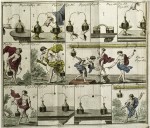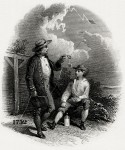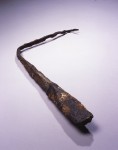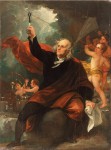 In 1746, Peter Collinson, wealthy merchant, philanthropist, botanist and Fellow of the Royal Society of London, gave Benjamin Franklin one of those newfangled Leyden jars that were all the rage. Well, technically he gave it to the Library Company of Philadelphia, but that was founded by Franklin and Collinson was a long-time friend and supporter of Franklin’s endeavors, so it was understood that Franklin was going to be using the new toy which could capture “electrical fire”. Thomas Penn, son of colony founder William Penn and inheritor of his title Proprietor of the Colony of Pennsylvania, chipped in all the rest of the equipment necessary to start investigating electrical phenomena, a pursuit engrossing many gentlemen of scientific disposition in the Old World at that time. The Library Company’s electrical setup formed the first scientific research laboratory in America.
In 1746, Peter Collinson, wealthy merchant, philanthropist, botanist and Fellow of the Royal Society of London, gave Benjamin Franklin one of those newfangled Leyden jars that were all the rage. Well, technically he gave it to the Library Company of Philadelphia, but that was founded by Franklin and Collinson was a long-time friend and supporter of Franklin’s endeavors, so it was understood that Franklin was going to be using the new toy which could capture “electrical fire”. Thomas Penn, son of colony founder William Penn and inheritor of his title Proprietor of the Colony of Pennsylvania, chipped in all the rest of the equipment necessary to start investigating electrical phenomena, a pursuit engrossing many gentlemen of scientific disposition in the Old World at that time. The Library Company’s electrical setup formed the first scientific research laboratory in America.
 Benjamin Franklin was hooked. Alongside Ebenezer Kinnersley, Thomas Hopkinson, and Philip Syng, Franklin studied and experimented with electricity for the next three years. From 1747 through 1750, he shared his findings in a series of letters to Collinson. In these letters Franklin detailed his experiments and described for the first time principles of electricity that are commonly held today. For example, he recognized that friction did not create electricity so much as collect it from materials like metal and water to which it was attracted; he coined the terms positive and negative/plus and minus to describe electrical charge (as opposed to the prevailing thought that they were two different kinds of electricity, “vitreous” named after the glass that accumulated electrical charge when rubbed with silk, and “resinous,” like amber rubbed with fur); he first used the terms “charging” and “discharging” for the operations of a Leyden jar; he coined the term “battery” for a group of connected jars that could store more charge than an individual jar, like a battery of cannon concentrated shot on the battlefield.
Benjamin Franklin was hooked. Alongside Ebenezer Kinnersley, Thomas Hopkinson, and Philip Syng, Franklin studied and experimented with electricity for the next three years. From 1747 through 1750, he shared his findings in a series of letters to Collinson. In these letters Franklin detailed his experiments and described for the first time principles of electricity that are commonly held today. For example, he recognized that friction did not create electricity so much as collect it from materials like metal and water to which it was attracted; he coined the terms positive and negative/plus and minus to describe electrical charge (as opposed to the prevailing thought that they were two different kinds of electricity, “vitreous” named after the glass that accumulated electrical charge when rubbed with silk, and “resinous,” like amber rubbed with fur); he first used the terms “charging” and “discharging” for the operations of a Leyden jar; he coined the term “battery” for a group of connected jars that could store more charge than an individual jar, like a battery of cannon concentrated shot on the battlefield.
Franklin also determined through experimentation that a sharp point is far more effective at drawing electricity than a blunt end. When he put a “long slender sharp bodkin” close to an electrically charged shot, it drew the charge from a foot away, while a “blunt body” had to be no more than an inch away and unlike the sharp point, it generated a spark. Extrapolating from his small-scale experiments, he proposed that a long, sharp rod properly grounded could save structures from the destruction of lightning.
I say, if these things are so, may not the knowledge of this power of points be of use to mankind, in preserving houses, churches, ships &c. from the stroke of lightning, by directing us to fix on the highest parts of those edifices, upright rods of iron made sharp as a needle, and gilt to prevent rusting, and from the foot of those rods a wire down the outside of the building into the ground, or down round one of the shrouds of a ship, and down her side till it reaches the water? Would not these pointed rods probably draw the electrical fire silently out of a cloud before it came nigh enough to strike, and thereby secure us from that most sudden and terrible mischief?
 For his idea of a lightning rod to work, first Franklin had to confirm that “clouds that contain lightning are electrified,” still an open question at the time. He suggested an experiment.
For his idea of a lightning rod to work, first Franklin had to confirm that “clouds that contain lightning are electrified,” still an open question at the time. He suggested an experiment.
On the top of some high tower or steeple, place a kind of sentry-box, big enough to contain a man and an electrical stand. From the middle of the stand, let an iron rod rise and pass bending out of the door, and then upright 20 or 30 feet, pointed very sharp at the end. If the electrical stand be kept clean and dry, a man standing on it when such clouds are passing low, might be electrified and afford sparks, the rod drawing fire to him from a cloud.
While Franklin did his experiments in Philadelphia, other people were doing similar work across the Atlantic. Collinson circulated the letters among the Royal Society fellows, including William Watson who at the same time as Franklin had independently determined that “vitreous” and “resinous” electricity were a surplus and deficiency, as he called it, of charge. In 1751, Collinson published the letters and other papers Franklin had sent him in a book, Experiments and Observations on Electricity Made at Philadelphia in America.
 Franklin’s writings were accepted but with subdued enthusiasm at first in Britain. In France, on the other hand, people were excited and inspired to try his experiments. Famed French naturalist Georges-Louis Leclerc, Comte de Buffon, received a copy of the book from Collinson and asked his frequent collaborator botanist Thomas-François Dalibard to translate it into French. Dalibard got so into it he enlisted the aid of a certain Delor who had the necessary equipment to replicate Franklin’s experiments. They worked so well that Buffon, Dalibard and Delor performed them before Louis XV and a delighted court where (forgive me) sparks flew.
Franklin’s writings were accepted but with subdued enthusiasm at first in Britain. In France, on the other hand, people were excited and inspired to try his experiments. Famed French naturalist Georges-Louis Leclerc, Comte de Buffon, received a copy of the book from Collinson and asked his frequent collaborator botanist Thomas-François Dalibard to translate it into French. Dalibard got so into it he enlisted the aid of a certain Delor who had the necessary equipment to replicate Franklin’s experiments. They worked so well that Buffon, Dalibard and Delor performed them before Louis XV and a delighted court where (forgive me) sparks flew.
Their success drove them to try the experiment that Franklin had described but not done yet: the sentry-box lightning rod experiment. They wisely forewent perching a man next to an iron rod in a box on top of a tower roof, modifying it into a test with distinctly less killing potential. A 13-meter (43-foot) iron rod insulated by silk ropes and wine bottles was inserted into a wooden table under a little roofed structure (the sentry-box). When a thunderstorm passed over, the iron rod drew sparks.
 Franklin didn’t hear about Dalibard’s experiment for a while. Meanwhile, he’d come up with a new idea to test the charge of storm clouds without the complications of the sentry-box. On June 15th, 1752, Benjamin Franklin and his son William flew a silk and cedar kite with a sharp wire at the top. Twine coming down from the kite had a silk ribbon tied to it and a key tried to the ribbon. This experiment has gone down in legend with an image of Benajamin Franklin running in the rain as lightning strikes the key, but in fact it was essential the silk ribbon stay dry so it could insulate the key from the ground and ensure the electric current accumulated in the key. Franklin was indoors while the kite was getting wet. If he hadn’t been, he never would have seen the sparks fly off the key.
Franklin didn’t hear about Dalibard’s experiment for a while. Meanwhile, he’d come up with a new idea to test the charge of storm clouds without the complications of the sentry-box. On June 15th, 1752, Benjamin Franklin and his son William flew a silk and cedar kite with a sharp wire at the top. Twine coming down from the kite had a silk ribbon tied to it and a key tried to the ribbon. This experiment has gone down in legend with an image of Benajamin Franklin running in the rain as lightning strikes the key, but in fact it was essential the silk ribbon stay dry so it could insulate the key from the ground and ensure the electric current accumulated in the key. Franklin was indoors while the kite was getting wet. If he hadn’t been, he never would have seen the sparks fly off the key.
When the news of Dalibard’s success reached him, Franklin installed an insulated iron rod on the roof of his home. Within a few months grounding conductors were installed in the Academy of Pennsylvania (now the University of Pennsylvania) and the Pennsylvania State House (now Independence Hall). In 1753, Franklin published instructions on how to protect homes from lightning strikes using iron rods in Poor Richard’s Almanack (page 72 of this pdf). Some people were apprehensive about it, railing at early adopters for attempting to defy God’s will and attracting deadly lightning, but over time lightning rods became commonplace and Franklin refined and modified his design to improve them.
 The invention of lightning rods saved not only property but lives. Before them, the only method considered valid against thunderstorms was in hindsight insanely counterproductive: vigorous ringing of church bells in the belief that sound could break up storm clouds. That put the poor bell ringers of the world up church steeples, the highest structures around, yanking on soaked ropes connected to large metal bells precisely when lightning was most likely to strike. The practice continued for decades after Franklin’s experiments proved there was a simple architectural solution that did not put lives in danger. A study by Johann Fischer published in Munich in 1784 found that in the 33 years between 1750 and 1783, bell towers were struck by lightning 386 times killing 103 bell ringers.
The invention of lightning rods saved not only property but lives. Before them, the only method considered valid against thunderstorms was in hindsight insanely counterproductive: vigorous ringing of church bells in the belief that sound could break up storm clouds. That put the poor bell ringers of the world up church steeples, the highest structures around, yanking on soaked ropes connected to large metal bells precisely when lightning was most likely to strike. The practice continued for decades after Franklin’s experiments proved there was a simple architectural solution that did not put lives in danger. A study by Johann Fischer published in Munich in 1784 found that in the 33 years between 1750 and 1783, bell towers were struck by lightning 386 times killing 103 bell ringers.
 During the Revolutionary period, the embrace of Franklin’s design for the lightning rod was a political statement of allegiance to New World ideas. In Britain the blunt-ended lightning rod was popular. Rejecting them in favor of Franklin’s sharp points was a philosophical choice. In 1788, the Maryland State House in Annapolis had a 28-foot lightning rod installed on its new dome according to Franklin’s specifications. It is still there, making its inventor proud. On Friday it was put through its paces and even after 208 years it handled the strike like a boss.
During the Revolutionary period, the embrace of Franklin’s design for the lightning rod was a political statement of allegiance to New World ideas. In Britain the blunt-ended lightning rod was popular. Rejecting them in favor of Franklin’s sharp points was a philosophical choice. In 1788, the Maryland State House in Annapolis had a 28-foot lightning rod installed on its new dome according to Franklin’s specifications. It is still there, making its inventor proud. On Friday it was put through its paces and even after 208 years it handled the strike like a boss.
[youtube=https://youtu.be/1eO0WNj16j4&w=430]